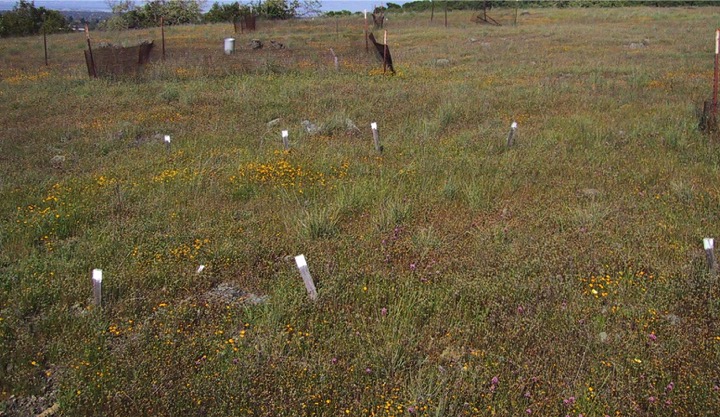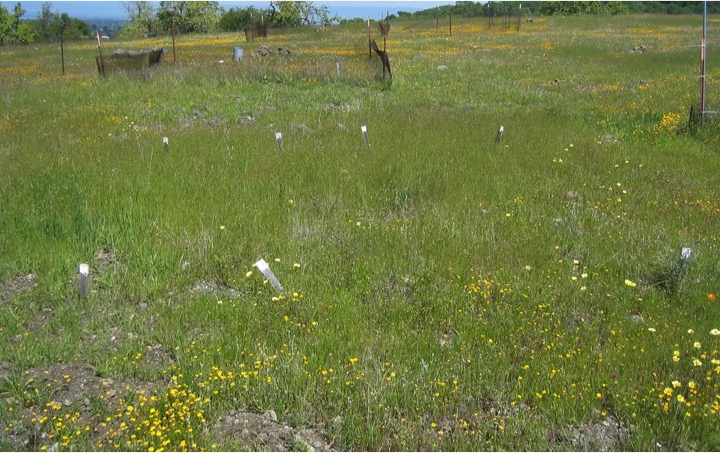Why do populations of the same species often fluctuate in synchrony across space? What causes different species to fluctuate in tandem with one another? How do these forms of synchrony scale to affect ecosystem stability?
Understanding factors that influence ecological stability is a fundamental question in ecology. A key insight from community ecology is that stable communities can be comprised of highly unstable populations of co-occurring species. In particular, asynchrony among species can result in community stability if a decline in one species is compensated by a rise in another. Consequently, the degree of community synchrony (i.e., interspecific synchrony in the same space) is an important indicator of the stability of ecosystem properties such as aggregate abundance or annual net primary production (ANPP). A second key insight from population ecology is that populations of the same species often fluctuate in synchrony across space. The degree of this population synchrony (i.e. intraspecific synchrony across space) is an important indicator of species stability, and can affect regional ecosystem functioning via outbreaks and extinctions.
To date these two lines of research on synchrony have developed largely independently, and our lab has primarily focused on the implications of community synchrony for stability of ecosystem properties. However, there is a growing body of theory that highlights the joint effects of population and community synchrony on overall ecosystem stability. We have begun collaborations that integrate population- and community-level approaches to synchrony to empirically understand the causes and effects of synchrony over space and time.
Community synchrony
The relationships between environmental variability, species diversity and community stability are highly debated. For example, environmental variability can destabilize species populations through increased stochasticity. However, it can also stabilize species diversity by structuring species tradeoffs (i.e., if different species are favored by different environmental conditions but can persist across unfavorable conditions). Scaling up, species tradeoffs may stabilize community properties (such as primary production) in variable environments if an increase in one species compensates for a decline in another. Past syntheses from our group have indicated that the stabilizing effect of species asynchrony in grasslands increases with precipitation varibility. Experimentally, we have shown that this phenomenon is dependent on the presence of stress-tolerant species that can “compensate” for a decline in resource-acquisitve species in drought years.
Population synchrony
Spatial synchrony - the correlation in fluctuations among populations across space - is a common feature of population dynamics. In the serpentine grasslands at Jasper Ridge, we observe strong spatial synchrony in the oscillations of species’ populations across the site. For example, in one year Microseris douglasii can be universally rare across the site, whereas a few years later it is highly abundant in every plot. In collaboration with Jon Walter, Dan Reuman, Lawrence Sheppard, Richard Hobbs, and Katie Suding, we are testing the factors that lead to this synchrony. In addition, we are finding a geographic signature in species synchrony, in which some plots are highly synchronous and others less so, regardless of proximity. We are testing both the mechanism of this “geography of synchrony” as well as its implications for species stability over time.
Linking community and population synchrony
The LTER Synchrony working group brings together quantitative and experimental ecologists to integrate methods and concepts from community and population synchrony. Currently, the group is exploring the time-scale specificity of synchrony, how geographies of synchrony relates to beta diversity, and how the drivers and consequences of synchrony shift at different spatial scales.
Related publications
Hallett, L. M., L. G. Shoemaker, C. T. White, K. N. Suding. Rainfall variability maintains grass-forb coexistence. In press, Ecology Letters.
Wang, S., T. Lamy, L. M. Hallett, M. Loreau. 2019. Stability and synchrony across ecological hierarchies in heterogeneous metacommunities: linking theory to data. In press, Ecography.
Hallett, L. M., E. C. Farrer, K. N. Suding, H. A. Mooney, R. J. Hobbs. 2018. Tradeoffs in demographic mechanisms underlie differences in species abundance and stability. Nature Communications 9, Article number: 5047.
Wilcox, K. R., A. T. Tredennick, S. E. Koerner, E. Grman, L. M. Hallett, M. L. Avolio, K. J. La Pierre, G. R. Houseman, F. Isbell, D. S. Johnson, et al. 2017. Asynchrony among local communities stabilizes ecosystem function of metacommunities. Ecology Letters 20(12): 1534-1545.
Hallett, L. M., C. Stein and K. N. Suding. 2017. Functional diversity increases ecological stability in a grazed grassland. Oecologia 183(3): 831-840.
Hallett, L. M., S. Jones, A. A. M. MacDonald, D. F. B. Flynn, J. Ripplinger, P. Slaughter, C. Gries, M. B. Jones, S. L. Collins. 2016. codyn: An R package for analysis of long-term ecological community data. Methods in Ecology and Evolution. DOI: 10.1111⁄2041-210X.12569
Hallett, L. M., J. S. Hsu, E. E. Cleland, S. L. Collins, T. L. Dickson, E. C. Farrer, K. L. Gross, L. A. Gherardi, R. J. Hobbs, L. Turnbull, K. N. Suding. 2014. Biotic mechanisms of community stability shift along a precipitation gradient. Ecology 95(6): 1693-1700.


